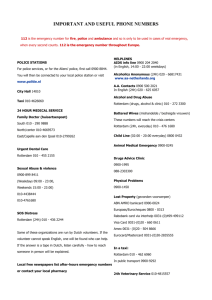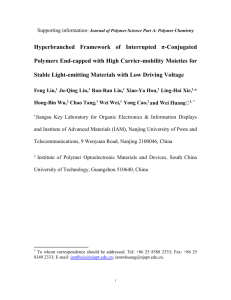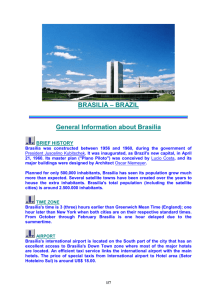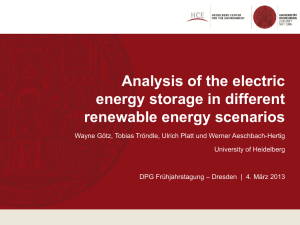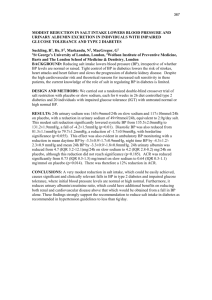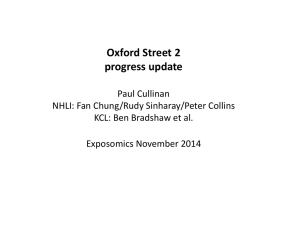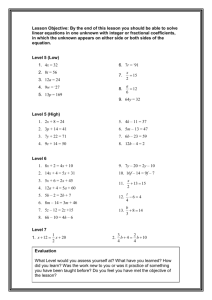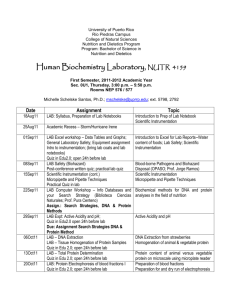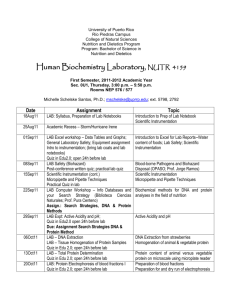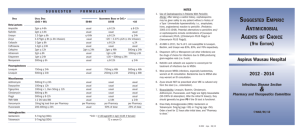Experimental Section
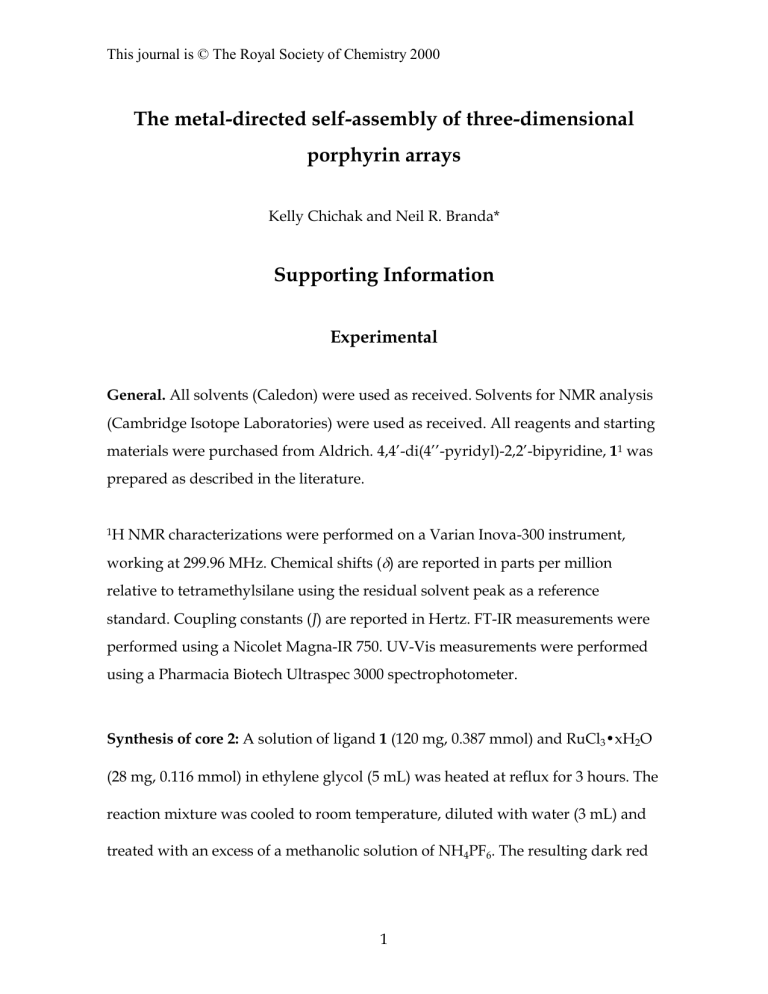
This journal is © The Royal Society of Chemistry 2000
The metal-directed self-assembly of three-dimensional porphyrin arrays
Kelly Chichak and Neil R. Branda*
Supporting Information
Experimental
General. All solvents (Caledon) were used as received. Solvents for NMR analysis
(Cambridge Isotope Laboratories) were used as received. All reagents and starting materials were purchased from Aldrich. 4,4’-di(4’’-pyridyl)-2,2’-bipyridine, 1 1 was prepared as described in the literature.
1 H NMR characterizations were performed on a Varian Inova-300 instrument, working at 299.96 MHz. Chemical shifts ( ) are reported in parts per million relative to tetramethylsilane using the residual solvent peak as a reference standard. Coupling constants (J) are reported in Hertz. FT-IR measurements were performed using a Nicolet Magna-IR 750. UV-Vis measurements were performed using a Pharmacia Biotech Ultraspec 3000 spectrophotometer.
Synthesis of core 2: A solution of ligand 1 (120 mg, 0.387 mmol) and RuCl
3
•xH
2
O
(28 mg, 0.116 mmol) in ethylene glycol (5 mL) was heated at reflux for 3 hours. The reaction mixture was cooled to room temperature, diluted with water (3 mL) and treated with an excess of a methanolic solution of NH
4
PF
6
. The resulting dark red
1
This journal is © The Royal Society of Chemistry 2000 precipitate was collected by filtration on a Celite pad and washed with water. The solid product was removed from the Celite by dissolving in acetonitrile and chromatographed through silica gel using acetonitrile-saturated aqueous potassium nitrate-water (7:1:2) as eluent. The red-orange band was collected and concentrated until a precipitate formed. The precipitate was collected by filtration, redissolved in acetonitrile and treated with excess NH
4
PF
6
. The addition of ether to this solution afforded the product as a red solid, which was collected by filtration and dried under vacuum. Yield 30 mg (20%):
1
H NMR (300 MHz, [D
6
]acetone,
22°C): = 9.53 (d, J = 1.5 Hz, 6H), 9.02 (dd, J = 1.5, 6.6 Hz, 12H), 8.46 (d, J = 6.0 Hz,
6H), 8.24 (dd, J = 1.5, 6.6 Hz, 12H), 8.07 (dd, J = 1.5, 6.0 Hz, 6H); MS (ES+): m/z =
516 [M –(2PF
6
)]
2+
.
Synthesis of arrays 2(TTP) and 2(OEP): A solution of 2 (1.51 x 10 -3 mM) in acetone was treated with 6.1-6.3 molar equivalents of [Ru(TTP)(CO)(EtOH)] or
[Ru(OEP)(CO)(EtOH)] and stirred with gentle heating (about 40°C) for 2 hours.
The complexes were precipitated by the addition of pentane and collected by filtration.
2(TTP): Yield 9.0 mg (98%):
1
H NMR (300 MHz, [D
6
]acetone, 22°C): = 8.62 (s,
48H), 8.13 (dd, J = 2.1, 7.8 Hz, 24H), 7.75 (dd, J = 1.8, 7.8 Hz, 24H), 7.71 (d, J = 8.5
Hz, 24H), 7.45 (d, J = 8.1 Hz, 24H), 7.27 (d, J = 1.8 Hz, 6H), 6.53 (d, J = 6.3 Hz, 6H),
6.02 (dd, J = 1.8, 6.0 Hz, 6H), 5.16 (d, J = 6.9 Hz, 12H), 2.73 (s, 72H), 1.37 (d, J = 6.9
2
This journal is © The Royal Society of Chemistry 2000
Hz, 12H);
1
H NMR (300 MHz, [D
2
]methylene chloride, 22°C): = 8.59 (s, 48H), 8.09
(dd, J = 2.1, 7.8 Hz, 24H), 7.74 (dd, J = 1.8, 7.8 Hz, 24H), 7.61 (d, J = 8.5 Hz, 24H),
7.37 (d, J = 8.1 Hz, 24H), 6.42 (d, J = 1.8, 6H), 5.91 (d, J = 6.3 Hz, 6H), 5.81 (dd, J = 1.8
Hz, 6.0 Hz, 6H), 4.97 (dd, J = 1.5, 6.9 Hz, 12H), 2.71 (s, 72H), 1.35 (dd, J = 1.5, 6.9 Hz,
12H); MS (ES+): m/z = 2909 [M –(2PF
6
)]
2+
; UV-Vis (methylene chloride) max
(log
/dm 3 mol -1 cm -1 ) 411 (6.10), 533 (5.03), 567 (4.56); IR( scope) (cm -1 ) = 1967 (CO).
2(OEP): Yield 7.2 mg (97%):
1
H NMR (300 MHz, [D
6
]acetone, 22°C): = 9.93 (s,
24H), 6.94 (s, 6H), 6.15 (d, J = 5.7 Hz, 6H), 5.73 (d, J = 6.0 Hz, 6H), 4.77 (d, J = 6.6 Hz,
12H), 4.16 (b, 96H), 1.93 (t, 144H), 0.73 (d, J = 6.0 Hz, 12H); 1 H NMR (300 MHz, [D
2
] methylene chloride, 22°C): = 9.93 (s, 24H), 6.98 (s, 6H), 6.53 (d, J = 5.7 Hz, 6H),
5.76 (dd, J = 1.8, 6.3 Hz, 6H), 4.81 (d, J = 6.9 Hz, 12H), 4.16 (b, 96H), 1.93 (t, 144H),
0.73 (d, J = 6.0 Hz, 12H); MS (ES+): m/z = 2503 [M –(2PF
6
)]
2+
; UV-Vis (methylene chloride) max
(log /dm 3 mol -1 cm -1 ) 394 (5.73), 518 (4.68), 548 (4.80); IR( scope)
(cm -1 ) = 1942 (CO).
Characterization of array 3(TTP):
1
H NMR (300 MHz, [D
6
]acetone/[D
2
]methylene chloride 22°C): = 8.60 (s, 48H), 8.08 (dd, J = 2.1, 7.8 Hz, 24H), 7.72 (dd, J = 1.8, 7.8
Hz, 24H), 7.62 (d, J = 8.5 Hz, 24H), 7.40 (d, J = 8.1 Hz, 24H), 7.13 (d, J = 1.8, 6H), 5.98
(d, J = 6.3 Hz, 6H), 5.89 (dd, J = 1.8, 6.0 Hz, 6H), 5.08 (dd, J = 1.5, 6.9 Hz, 12H), 2.71
(s, 72H), 1.33 (dd, J = 1.5, 6.9 Hz, 12H);
1
H NMR (300 MHz, [D
2
]methylene chloride,
3
This journal is © The Royal Society of Chemistry 2000
22°C): = 8.59 (s, 48H), 8.09 (dd, J = 2.1, 7.8 Hz, 24H), 7.74 (dd, J = 1.8, 7.8 Hz, 24H),
7.61 (d, J = 8.5 Hz, 24H), 7.37 (d, J = 8.1 Hz, 24H), 6.42 (d, J = 1.8, 6H), 5.91 (d, J = 6.3
Hz, 6H), 5.81 (dd, J = 1.8, 6.0 Hz, 6H), 4.97 (dd, J = 1.5, 6.9 Hz, 12H), 2.71 (s, 72H),
1.35 (dd, J = 1.5, 6.9 Hz, 12H); MS (ES+): m/z = 2888 [M –(2PF
6
)] 2+ ; UV-Vis
(methylene chloride) max
(log /dm 3 mol -1 cm -1 ) 411 (5.96), 583 (4.95), 567 (4.58);
(cm -1 ) = 1948 (CO).
1 R. J. Morgan and A. D. Baker, J. Org. Chem., 1990, 55, 1986.
4


